Lilies are some of the most popular ornamental plants among home gardeners. These easy-to-grow plants create quite the statement in garden beds, thanks to their rich foliage and oversized, colorful blooms. But if you’re in the market for lilies for your garden, you may be overwhelmed by the sheer number of species!
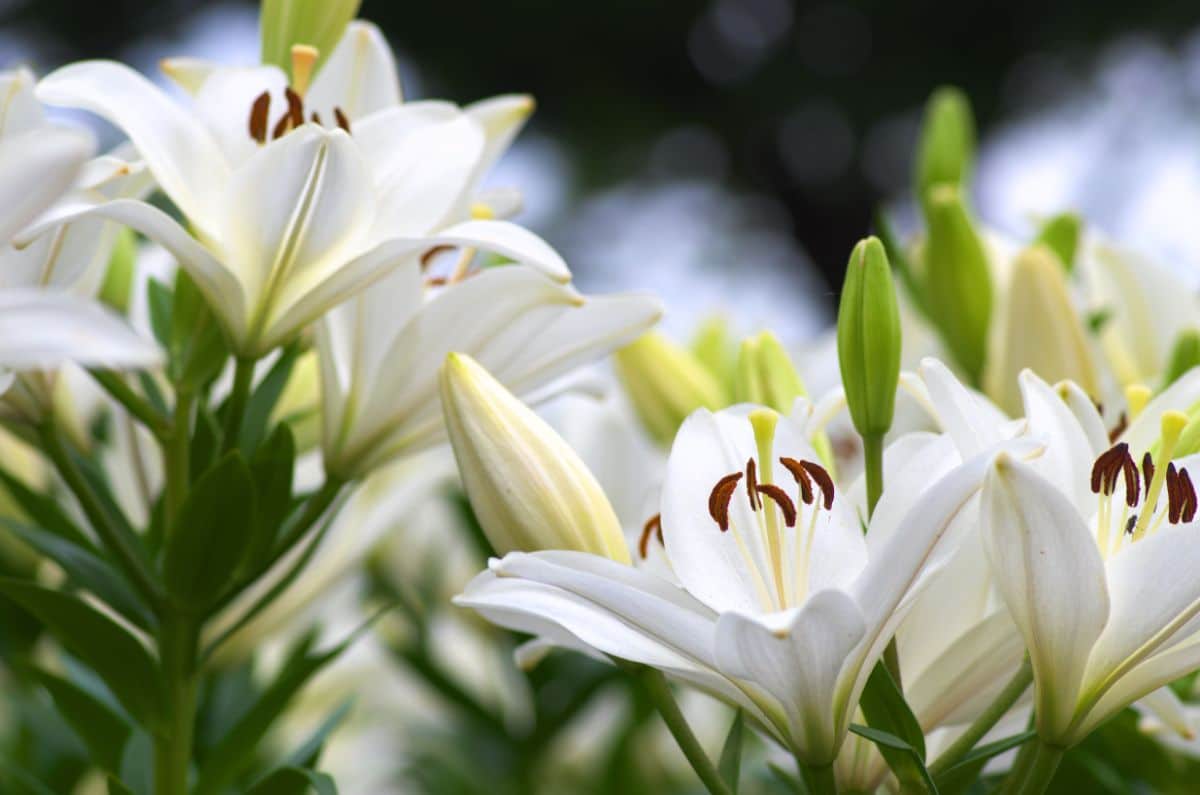
Today, there are over 90 different species of lilies, ranging from dwarf plants that are perfect for containers to larger specimens that grow 6’ high or larger. Some lily varieties are well-suited for shady beds, while others prefer full sun. And, if you need even more options, different lily species bloom at different times of the year!
To help you sort through all of those lily bulbs, we’ve compiled this list of some of the most popular lily types to grow. We’ve also included helpful details, such as bloom time and fragrance notes, to help you choose the right lily species for you.
Jump to:
- 21 Favorite Lily Varieties to Try in Your Garden
- 1. Daylily (Hemerocallis spp.)
- 2. Easter Lily (Lilium Longiflorum)
- 3. ‘Stargazer’ (Lilium orientalis ‘Stargazer’)
- 4. Tiger Lily (Lilium Lancifolium)
- 5. ‘Casablanca’ (Lilium ‘Casa Blanca’)
- 6. Japanese Lily (Speciosum rubrum)
- 7. ‘Regal’ (Lilium regale)
- 8. ‘Acapulco’ (Lilium ‘Acapulco’)
- 9. ‘Matrix’ (Lilium asiaticum ‘Matrix’)
- 10. ‘Fire’ (Lilium bulbiferum)
- 11. ‘Tiny Bee’ (Lilium asiaticum ‘Tiny Bee’)
- 12. ‘Luxor’ (Lilium x hybridum ‘Luxor’)
- 13. Trumpet Lily (Lilium ‘African Queen’)
- 14. ‘Bright Star’ (Lilium ‘Bright Star’)
- 15. ‘Golden Splendor’ (Lilium ‘Golden Splendor’)
- 16. Leopard Lily (Lilium pardilinum)
- 17. ‘Forever Susan’ (Lilium ‘Forever Susan’)
- 18. ‘Dizzy’ (Lilium ‘Dizzy’)
- 19. ‘Lollipop’ (Lilium ‘Lollipop’)
- 20. ‘Turk’s Cap’ (Lilium superbum)
- 21. ‘Elodie’ (Lilium maculatum ‘Elodie’)
- Frequently Asked Questions
- Summary
21 Favorite Lily Varieties to Try in Your Garden
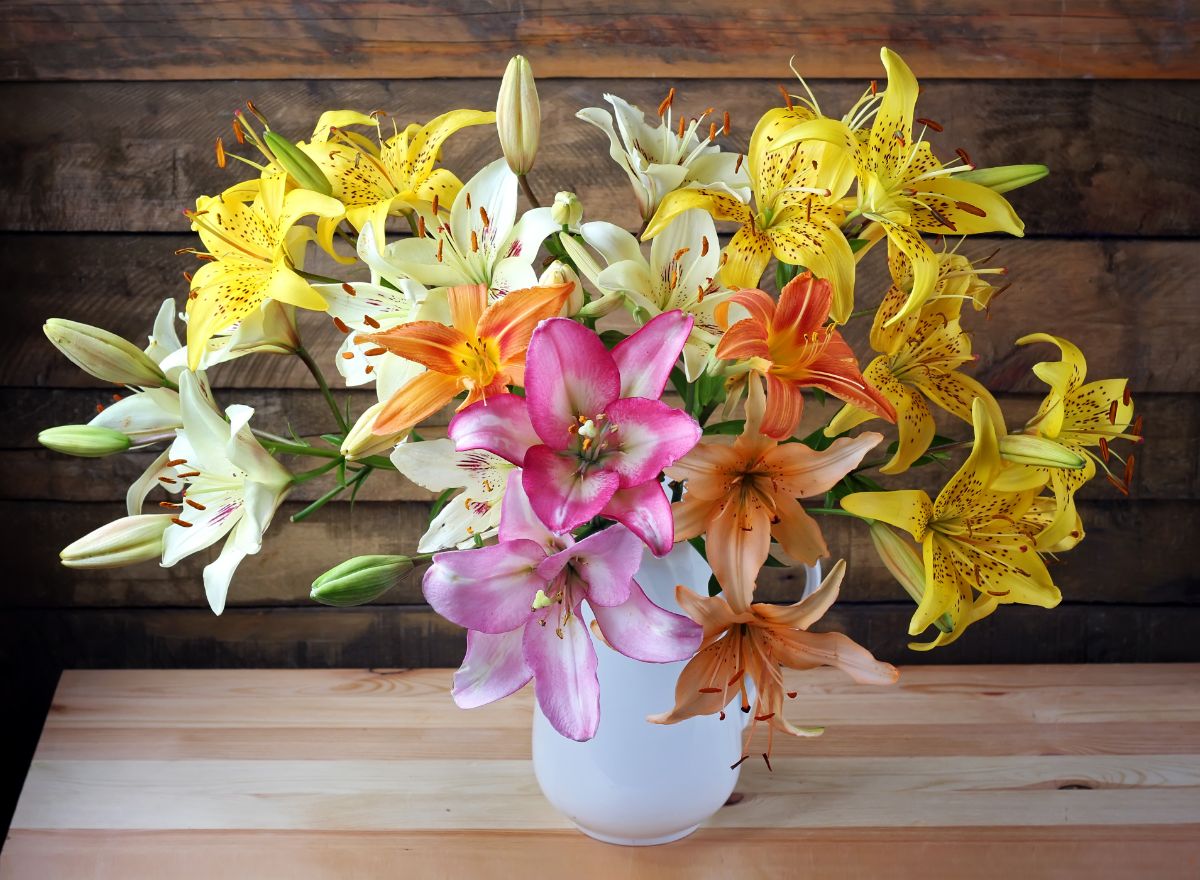
Whether you prefer delicate flowers or tropical-looking blooms, you’ll find the perfect lily type for your garden in the list below. For greater variety, we’ve included lilies with different colored blooms, varied bloom times, and some unscented and scented options, so you’re sure to find the right lily type for your garden.
1. Daylily (Hemerocallis spp.)
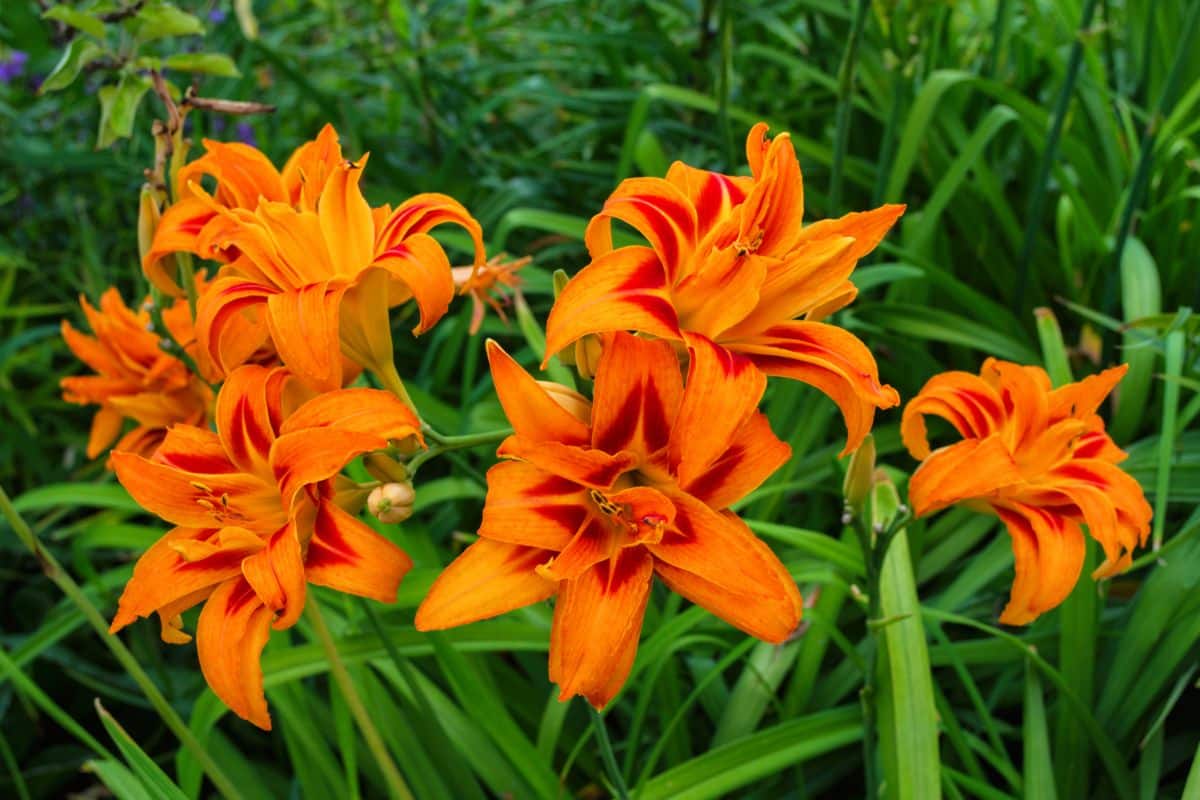
| Plant name: | Daylily |
| Lighting requirements: | Full sun to part shade |
| Most common bloom color: | Orange |
| Bloom time: | Early to mid-summer |
| Growing zone: | Zones 4 to 9 |
Daylilies are some of the most popular lily varieties to grow; however, surprisingly, they’re not true lilies! These garden favorites may boast similarly shaped flowers, but their longer, grass-like leaves are quite different from the shorter leaves of true lilies. Daylily flowers also appear at the end of long stems (known as scapes), which are distinct structures from the plant’s leaves.
Although daylilies are not true lilies, they will work well in many different backyard spaces and are a good choice if you don’t want to grow lilies or you have a shadier lawn. Daylilies can tolerate more shade than many true lily types. And these plants offer lots of garden color in their richly hued, orange, yellow, red, pink, or white blooms.
2. Easter Lily (Lilium Longiflorum)
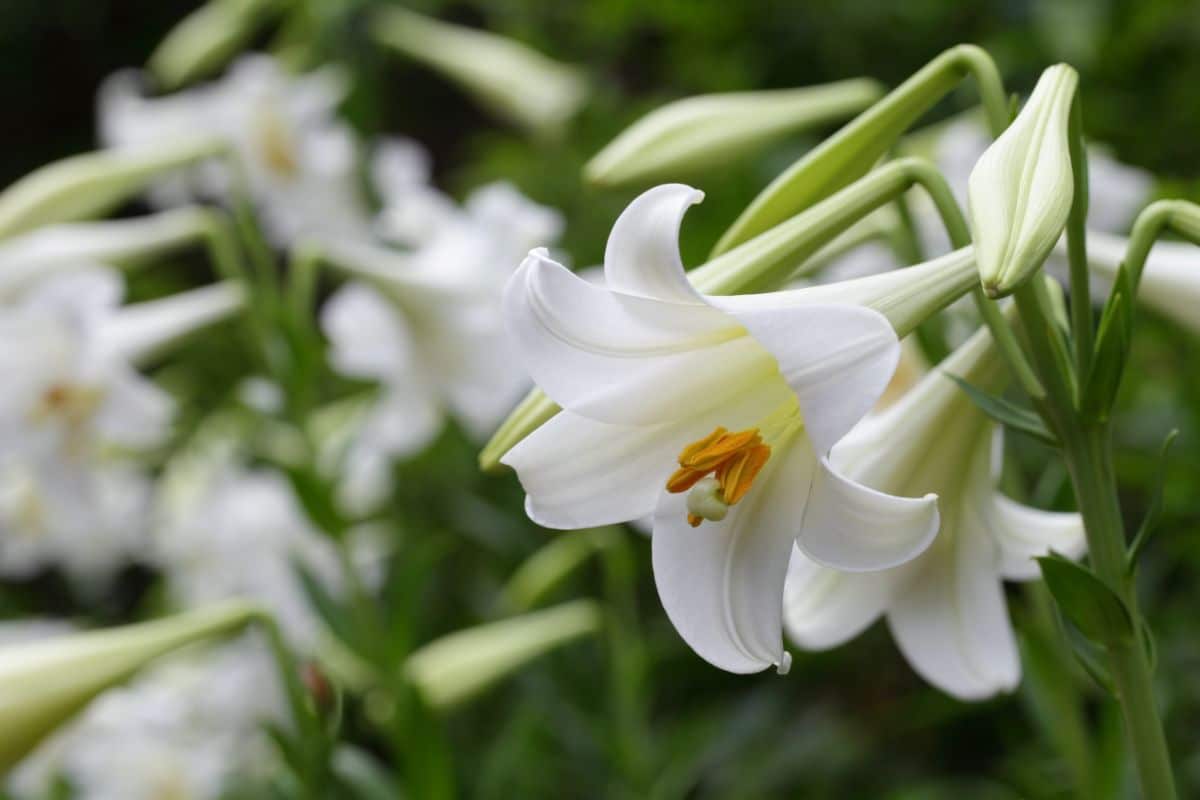
| Plant name: | Easter lily |
| Lighting requirements: | Full to part sun |
| Most common bloom color: | White |
| Bloom time: | Early to mid-summer |
| Growing zone: | Zones 7 and up |
Ever-popular Easter lilies have a more compact growth habit than many other lily varieties. White, trumpet-shaped flowers appear at the tops of slender stems and are very fragrant.
Leaves are short and deep green in color and drape delicately from the plant’s stem.
Growing about 36” high, Easter lilies bloom from early to mid-summer and produce about 12 to 15 flowers overall. Hardy to zone 7, these pretty plants can be kept as annuals in cooler regions. Alternatively, northern growers can also overwinter their lilies indoors; just keep in mind that all lilies are toxic to pets.
3. ‘Stargazer’ (Lilium orientalis ‘Stargazer’)
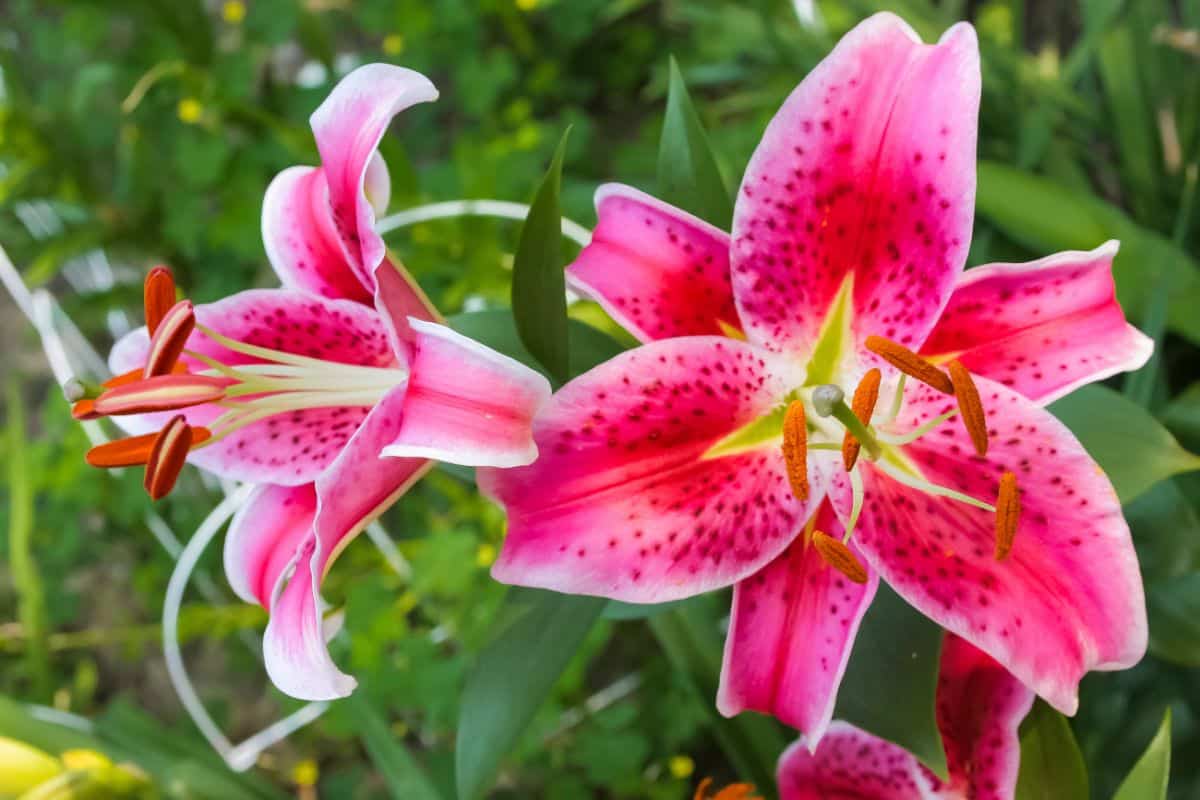
| Plant name: | ‘Stargazer’ |
| Lighting requirements: | Full sun |
| Most common bloom color: | Pink |
| Bloom time: | Mid-summer |
| Growing zone: | Zones 4 to 9 |
Named for its upward-facing flowers that point “towards the heavens,” ‘Stargazer’ lilies are some of the most popular oriental lilies for home growers. Bold, pink, and white flowers bloom in July and are highly fragrant with a slightly spicy aroma. Their bright petals make them a favorite choice among florists for bouquets and other floral arrangements.
Stargazer lilies grow between 3 to 4’ high and can be kept in inground ornamental beds or planters. Just provide your plants with plenty of bright sun and you should be good to go.
4. Tiger Lily (Lilium Lancifolium)
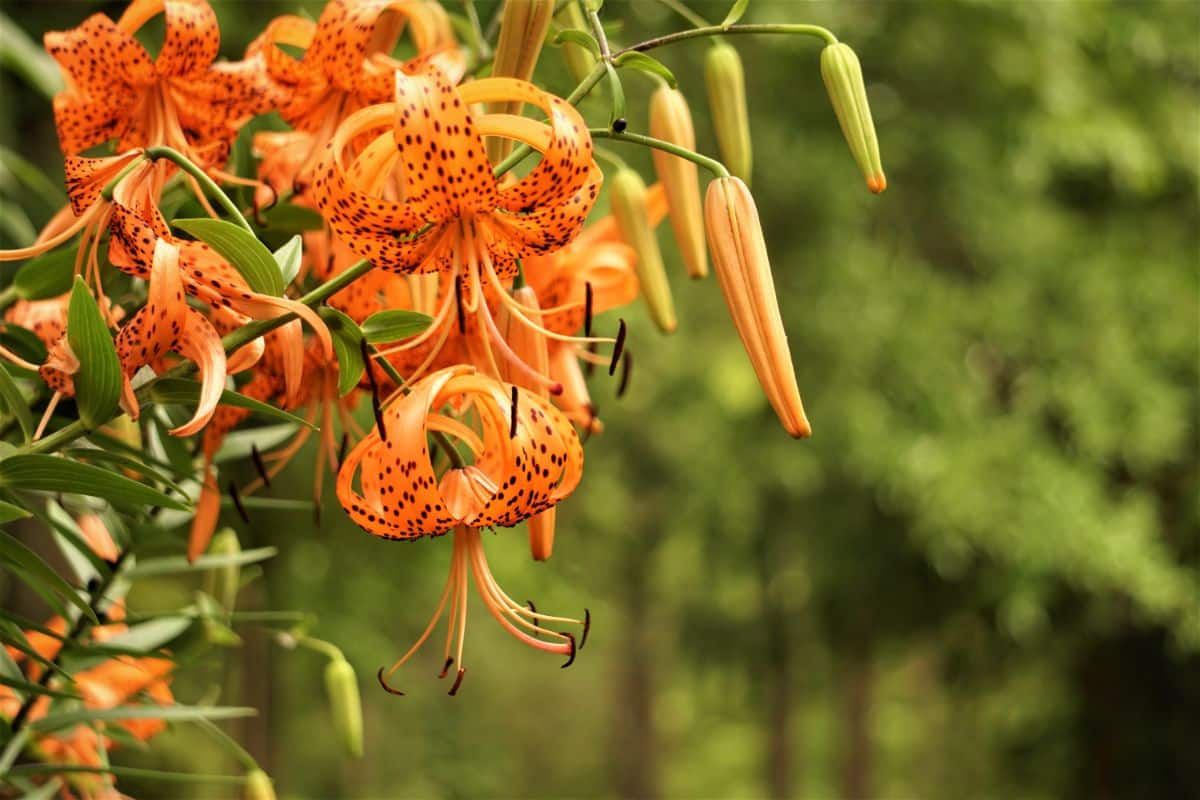
| Plant name: | Tiger lily |
| Lighting requirements: | Full to part sun |
| Most common bloom color: | Orange |
| Bloom time: | Mid- to late summer |
| Growing zone: | Zones 3 to 9 |
A classic lily type, tiger lilies grow up to 5’ high and feature long, dark, slender stems adorned with short, gently draping leaves. But, of course, the true star of the show are the bright orange, downward-facing flowers, with petals that arch back towards the plant’s stem, creating a beautiful summertime show. Look closer, and you’ll notice those petals are speckled with lots of little dark spots for even more visual interest.
Native to Asia, the tiger lily is a prolific grower and has become naturalized in many areas, including parts of the United States. While flowers are not fragrant, they are incredibly disease and pest-resistant. In fact, tiger lilies are usually able to resist many diseases that other lilies can’t survive.
5. ‘Casablanca’ (Lilium ‘Casa Blanca’)
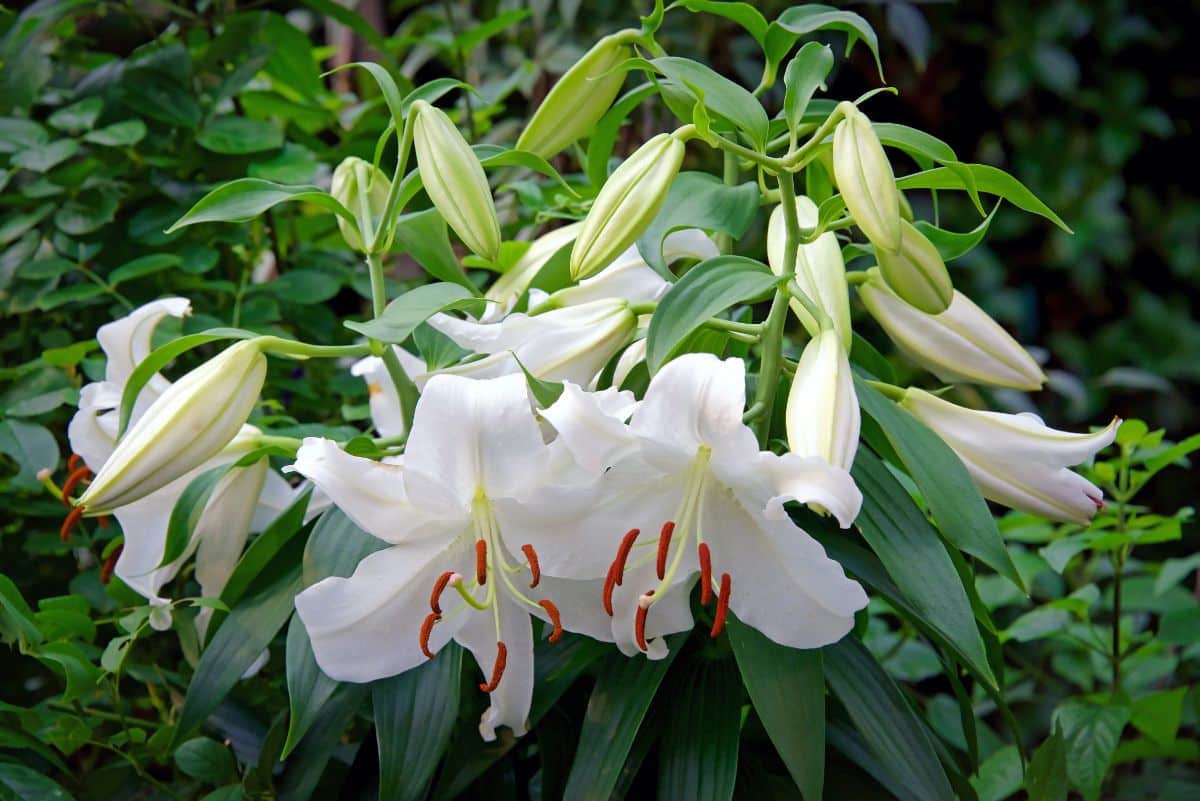
| Plant name: | ‘Casablanca’ |
| Lighting requirements: | Full sun |
| Most common bloom color: | White |
| Bloom time: | Mid- to late summer |
| Growing zone: | Zones 3 to 9 |
Casablanca lilies are elegant in both look and name. This plant’s large, white blooms often have a slightly pale greenish cast and are highly fragrant. Prized in cut flower arrangements, ‘Casa Blanca’ lilies are also the lily of choice for scent gardens and evening moon gardens.
Growing between 3 and 4’ high, ‘Casa Blanca’ lilies flower from mid to late summer. As a hardy species, these lilies are well-suited to northern climates too. Just remember to deadhead spent blooms to keep your plants looking their best throughout the growing season.
6. Japanese Lily (Speciosum rubrum)
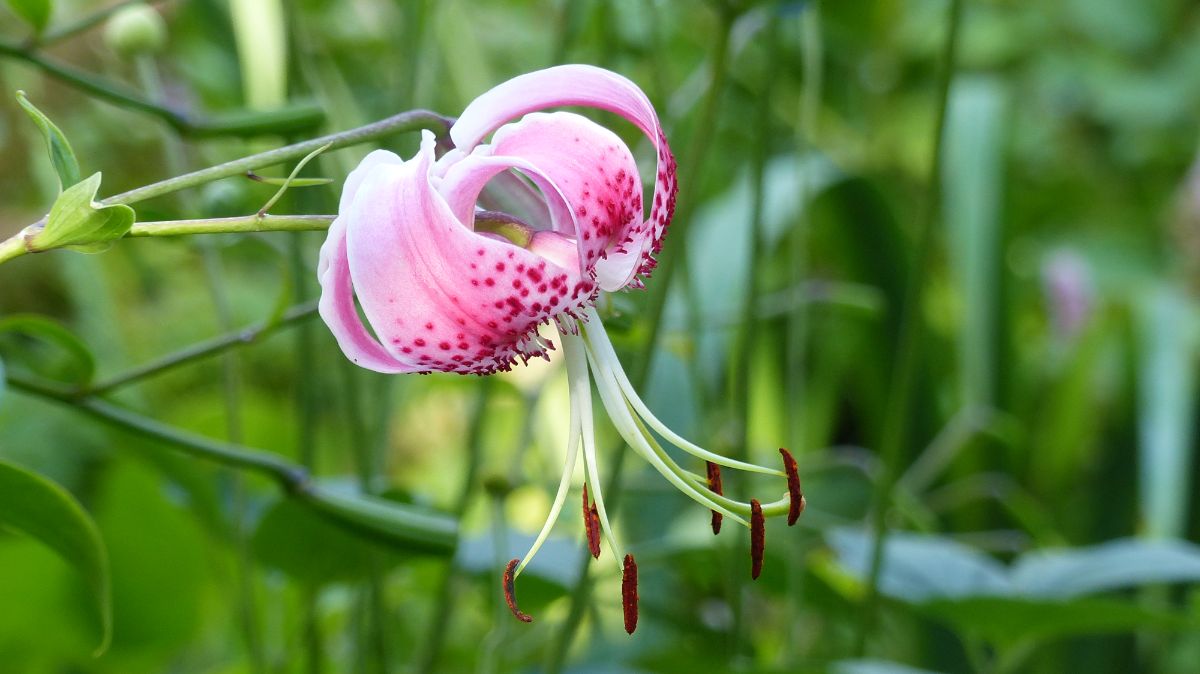
| Plant name: | Japanese Lily |
| Lighting requirements: | Full to part sun |
| Most common bloom color: | Pink, orange or yellow |
| Bloom time: | Early autumn |
| Growing zone: | Zones 5 to 7 |
Originating in Japan, this lily type features bright and fragrant flowers with petals that arch backward toward the plant’s stem. Flowers are most commonly sighted in white or pink and are ornamented with raised bumps (papillae) and dark spots for even more color.
An ideal choice for succession planting, Japanese lilies bloom in autumn, which is later than most other lily types. This makes them a great complement to earlier blooming species and also means that they are a good choice for pollinator gardens as they will provide food for bees after other flowers fade. Just keep in mind that these plants don’t like alkaline soil or lime, so they are best planted in pots if your garden soil has a high pH.
7. ‘Regal’ (Lilium regale)

| Plant name: | ‘Regal’ |
| Lighting requirements: | Full sun to part shade |
| Most common bloom color: | White and yellow |
| Bloom time: | Early to mid-summer |
| Growing zone: | Zones 4 to 8 |
Similar in appearance to the Easter lily, ‘Regal’ lilies offer oversized white, trumpet-shaped flowers in profusion. A single plant will often produce two dozen flowers, which can measure up to 6” each. This impressive display is only augmented by the plant’s slightly pinkish buds that contrast well against the plant’s white blooms.
But ‘Regal’ lilies won’t just bewitch you with their beauty; they also emit a strong fragrance that will make garden strolls that much more memorable. Additionally, the bright flowers show well after dark, making them a good choice for moon gardens. These adaptable plants can even tolerate some shade!
8. ‘Acapulco’ (Lilium ‘Acapulco’)
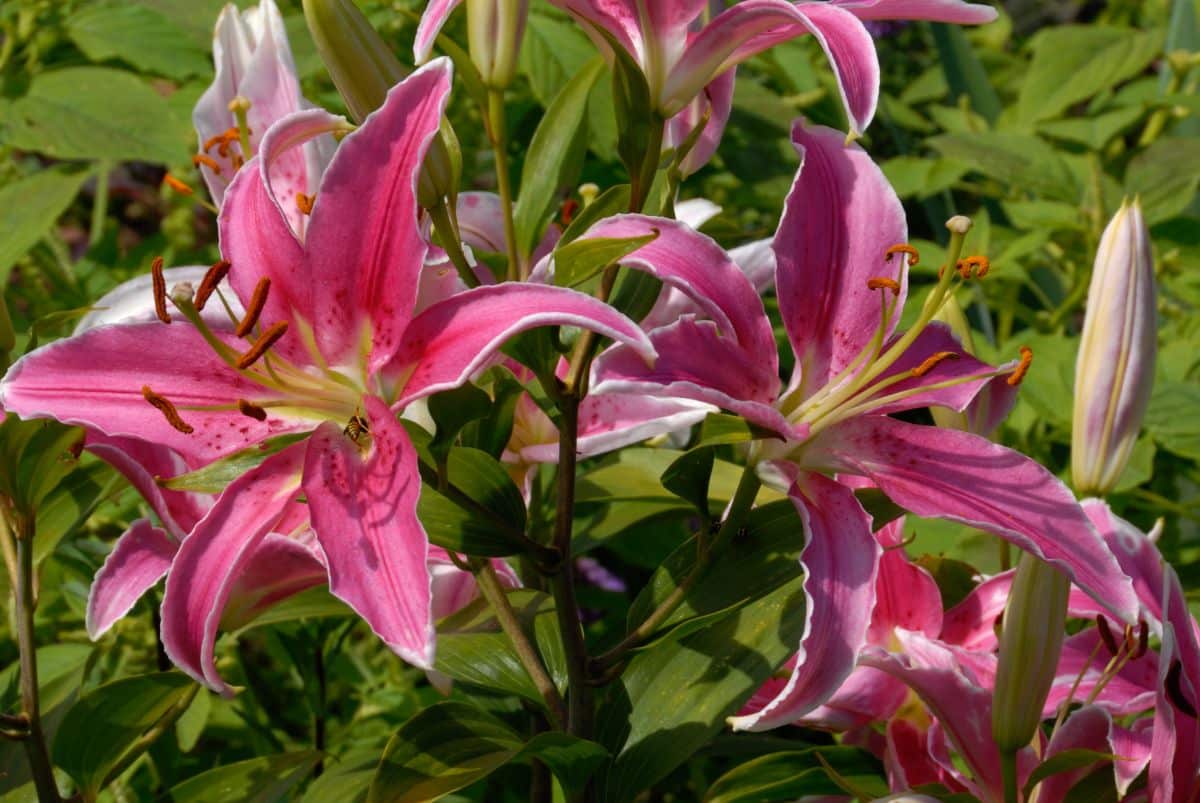
| Plant name: | ‘Acapulco’ |
| Lighting requirements: | Full sun to part shade |
| Most common bloom color: | Pink |
| Bloom time: | Mid- to late summer |
| Growing zone: | Zones 3 to 8 |
If you like pink, you need to grow ‘Acapulco’ lilies. These feminine flowers feature darker pink centers that are ornamented with lots of deeper-hued spots. Petals lighten towards their margins and often have slightly ruffled edges that create a more delicate flower shape.
One of the top choices for cut flower arrangements and bouquets, ‘Acapulco’ is very fragrant and smells wonderful in garden beds too! Adapted to full sun to part shade, expect your lilies to bloom in mid-to-late summer for lots of garden color. Plants also grow about 3 to 4’ high, which makes them well-suited for planting in the center of garden beds or in containers, depending on your available garden space.
9. ‘Matrix’ (Lilium asiaticum ‘Matrix’)
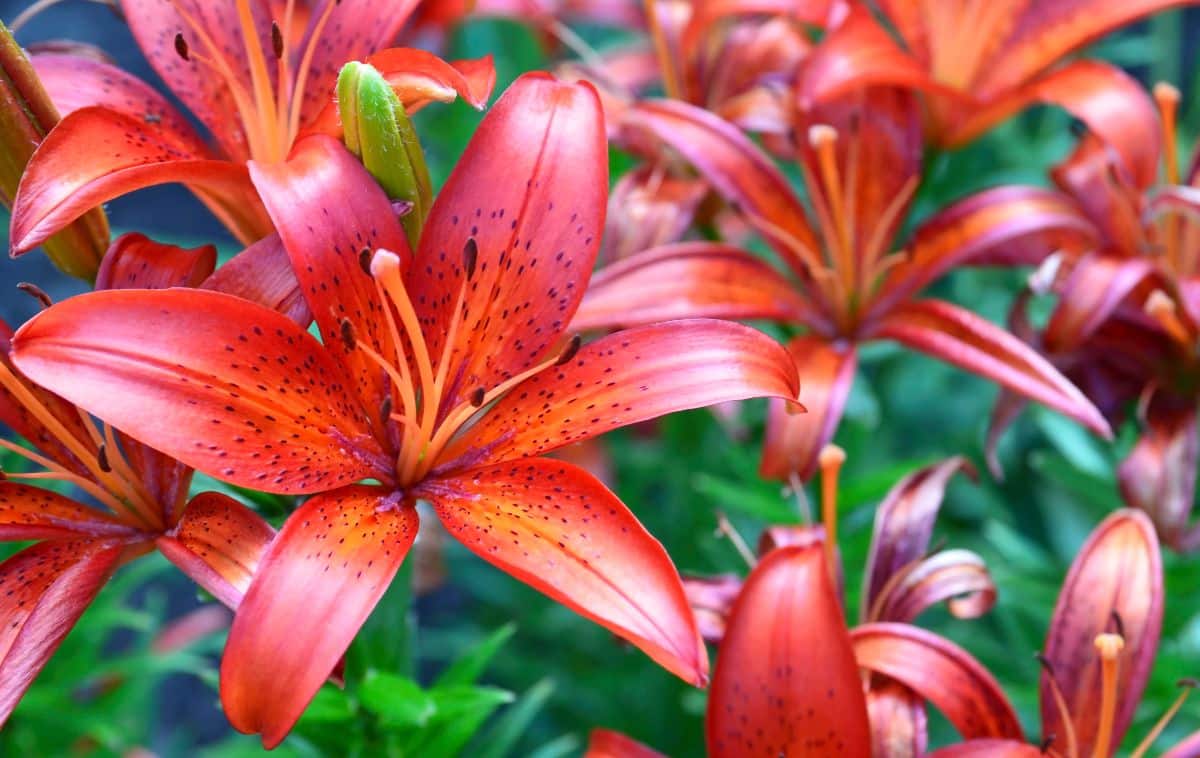
| Plant name: | ‘Matrix’ |
| Lighting requirements: | Full sun to part shade |
| Most common bloom color: | Reddish orange |
| Bloom time: | Mid-summer to early fall |
| Growing zone: | Zones 4 to 8 |
‘Matrix’ lilies are a smaller, Asiatic species that only grows to about 2’ in height. Their petite form makes ‘Matrix’ a wonderful plant to try towards the front of ornamental beds or in container gardens. Once planted, prepare to be “wowed” by the brightly colored red blooms that have lighter, yellow-orange throats.
This dwarf lily variety may be smaller, but it is still highly aromatic and will add plenty of spicy fragrance to your outdoor space. Leaves also maintain their color throughout the season, so even after flowers fade, the plants will still look nice and crisp. ‘Matrix’ lilies are moderate bloomers and produce about 7 flowers per plant.
10. ‘Fire’ (Lilium bulbiferum)
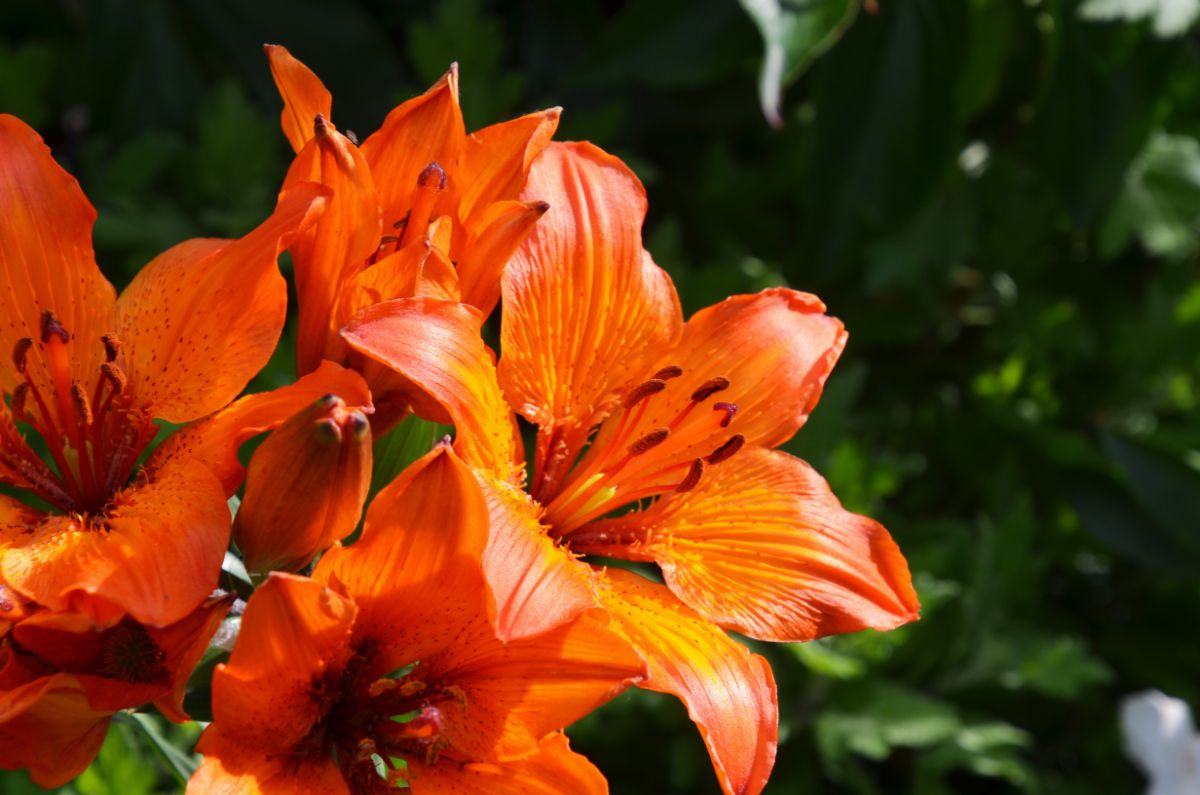
| Plant name: | ‘Fire’ |
| Lighting requirements: | Full to part sun |
| Most common bloom color: | Reddish orange |
| Bloom time: | Early summer |
| Growing zone: | Zones 3 to 9 |
Native to the mountains of southern Europe, ‘Fire’ lilies have been used by gardeners to develop many different types of Asiatic hybrid lilies. This is likely due to this species’ pretty bowl-shaped flowers that come in a warm yellow-orange color. Like many other ornamental lilies, ‘Fire’ lilies’ petals are adorned with contrasting speckles in a rich, chocolate brown.
A smaller lily type, ‘Fire’ lilies may only grow about 30” tall when mature, but they make vibrant garden additions, nonetheless. These plants are also easy to propagate from the small bulbs (bulbils) that can be pulled away from the plant’s stem and sown independently. And, if you need more reasons to love these plants, they are highly fragrant as well!
11. ‘Tiny Bee’ (Lilium asiaticum ‘Tiny Bee’)
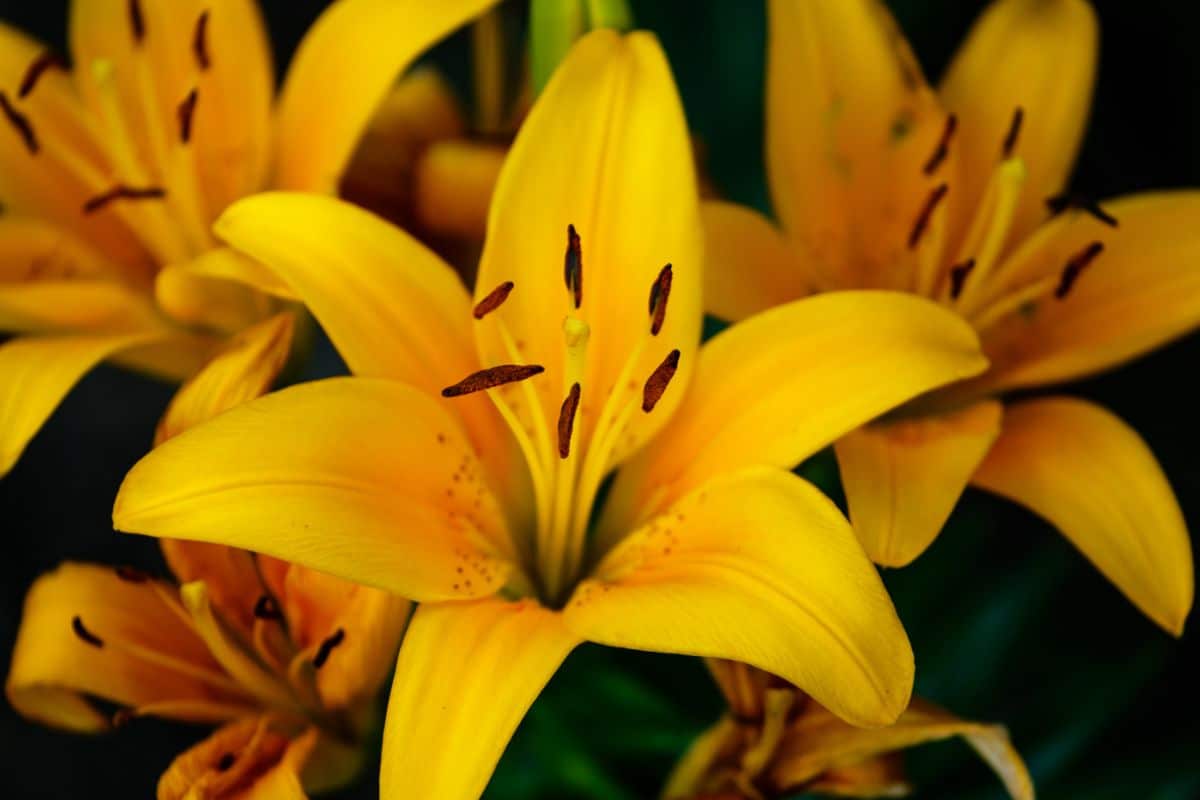
| Plant name: | ‘Tiny Bee’ |
| Lighting requirements: | Full sun to part shade |
| Most common bloom color: | Yellow |
| Bloom time: | Mid-summer |
| Growing zone: | Zones 2 to 9 |
Like little rays of sunshine in the garden, ‘Tiny Bee’ blooms bright yellow flowers that can gladden even the drabbest of garden beds. A type of Asiatic lily, ‘Tiny Bee’, is a profuse bloomer with flowers that open early in the summer. Flowers are generally scent-free, so they are a good solution if you don’t tolerate scented flowers well.
A type of dwarf lily, ‘Tiny Bee’, only grows about 1 to 2’ high, which makes them well-adapted to container gardens. They can also be planted towards the front of garden beds and pair nicely with taller lily types, like tiger lilies and trumpet lilies. Their petite size also makes them hardy in windier locations.
12. ‘Luxor’ (Lilium x hybridum ‘Luxor’)
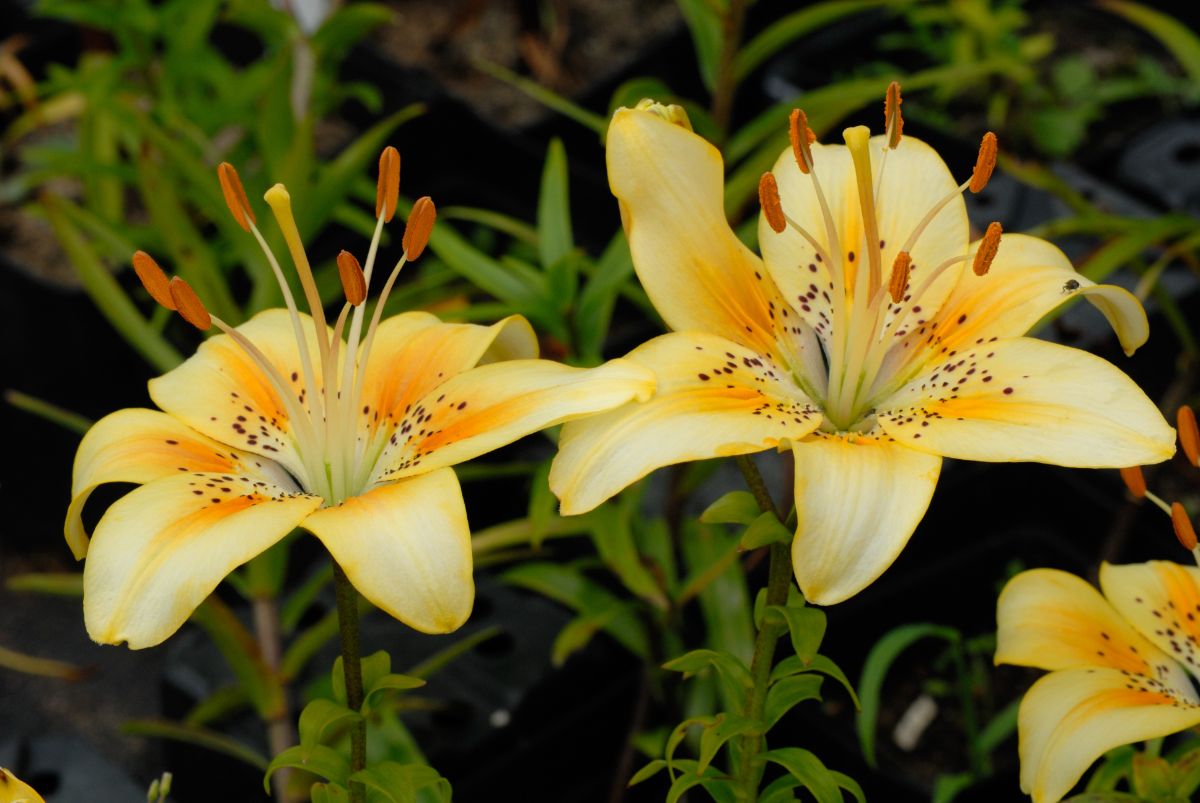
| Plant name: | ‘Luxor’ |
| Lighting requirements: | Full sun to part shade |
| Most common bloom color: | Yellow |
| Bloom time: | Mid-summer |
| Growing zone: | Zones 3 to 8 |
Bright yellow and creamy petals create the distinct look of this charming lily variety. Blooms are quite wide and produce a funnel shape as they narrow towards the center. The interior of the flower is often a bit darker than the petals and may exhibit bronze tones with delicate speckling.
Produced from Asiatic lily varieties, ‘Luxor’ wows with an abundance of aromatic blooms in mid-summer. They are also long-lived plants and are often included in cut flower gardens, as their straight stems are just right for floral arrangements. Growing to about 3’ in height, ‘Luxor’ can also grow in partially shaded areas in addition to full sun beds.
13. Trumpet Lily (Lilium ‘African Queen’)
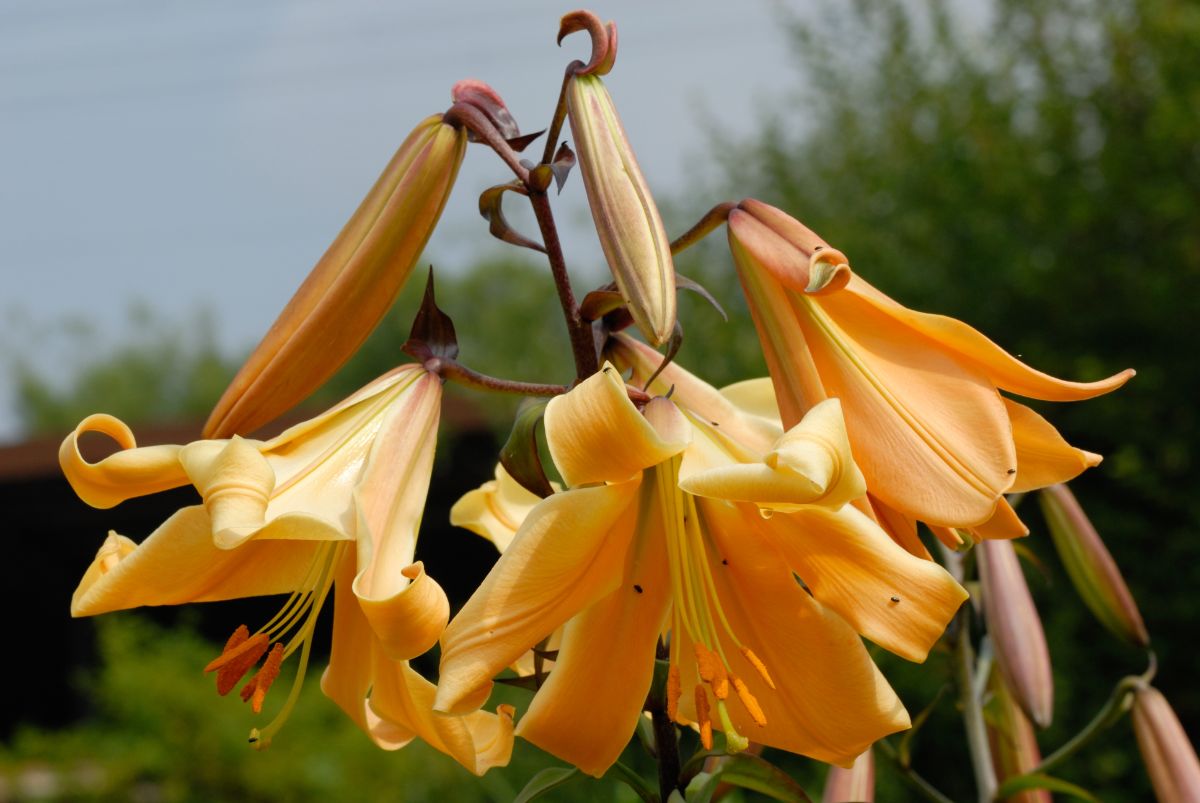
| Plant name: | Trumpet Lily |
| Lighting requirements: | Full sun |
| Most common bloom color: | White and yellow |
| Bloom time: | Mid- to late summer |
| Growing zone: | Zones 3 to 8 |
If you want to bring a tropical feel to your outdoor space, look no further than ‘African Queen.’ These oversized, trumpet-shaped flowers come in a warm golden-orange color, while buds and outer petals are pinkish-purple in color, creating a truly vibrant garden display. Plants can grow very tall (up to 6’ high), which helps highlight the slightly downward-facing blooms.
A hardy and adaptable lily variety, ‘African Queen’ can grow in a range of conditions; however, it prefers lots of bright sun and well-draining soil. Fragrant flowers bloom from July to August and look especially nice when paired with earlier and later blooming lily varieties, like ‘Fire’ lilies and Oriental lilies.
14. ‘Bright Star’ (Lilium ‘Bright Star’)
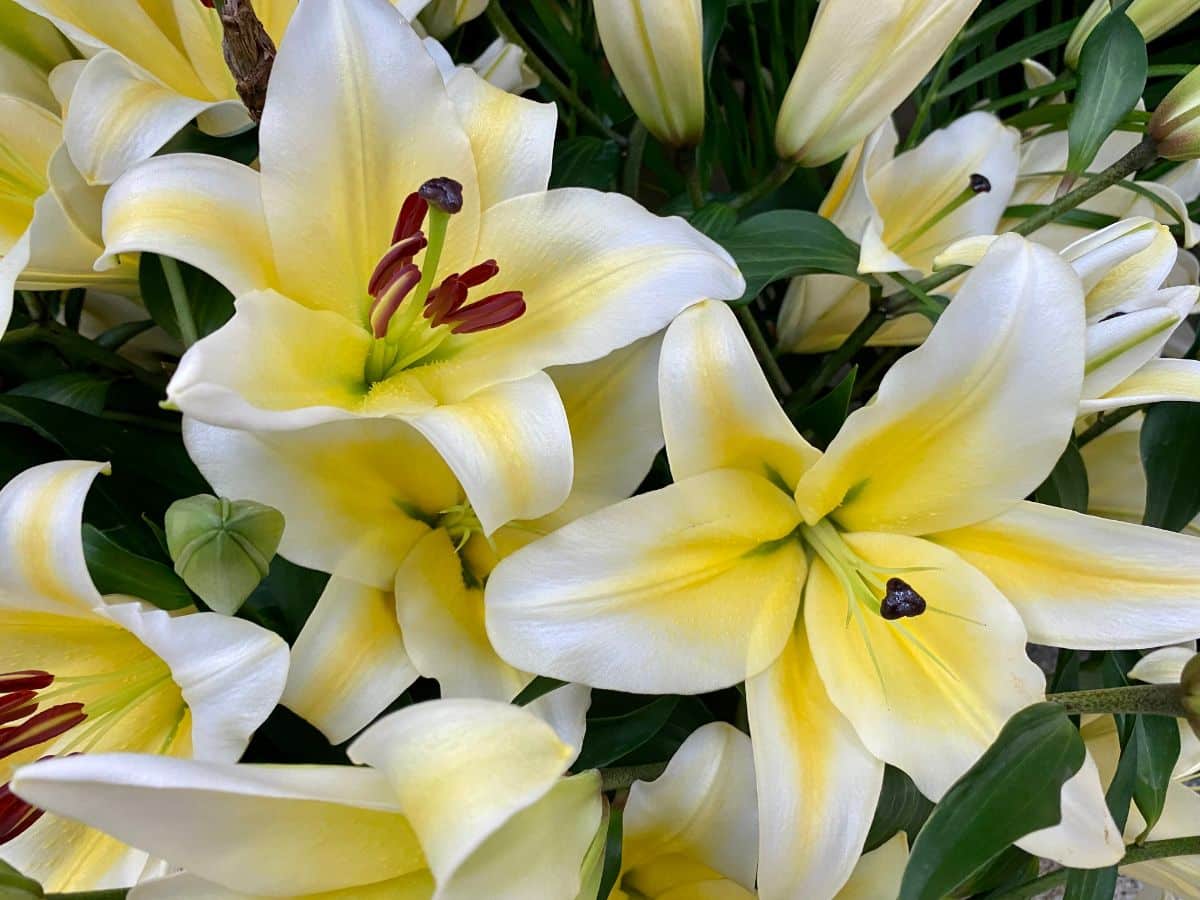
| Plant name: | ‘Bright Star’ |
| Lighting requirements: | Full sun to part shade |
| Most common bloom color: | White and yellow |
| Bloom time: | Summer |
| Growing zone: | Zones 3 to 8 |
‘Bright Star’ blooms in mid-to-late summer with large and showy white and yellow flowers. These highly aromatic flowers are long-lasting, but they should be deadheaded once they begin to fade to redirect your plant’s energy. Plants grow between 3 and 5’ high and make a fine complement to shrubbery or taller ornamental flowers.
A hardy plant, ‘Bright Star’ can tolerate alkaline soil better than some other lily types. In autumn, prep your lilies for winter slumber by nipping the plants off a few inches above the soil line after the foliage and stems begin to turn yellow. While ‘Bright Star’ is a relatively drought-tolerant variety, it will benefit from a bit of extra moisture once flowers begin to bloom.
15. ‘Golden Splendor’ (Lilium ‘Golden Splendor’)
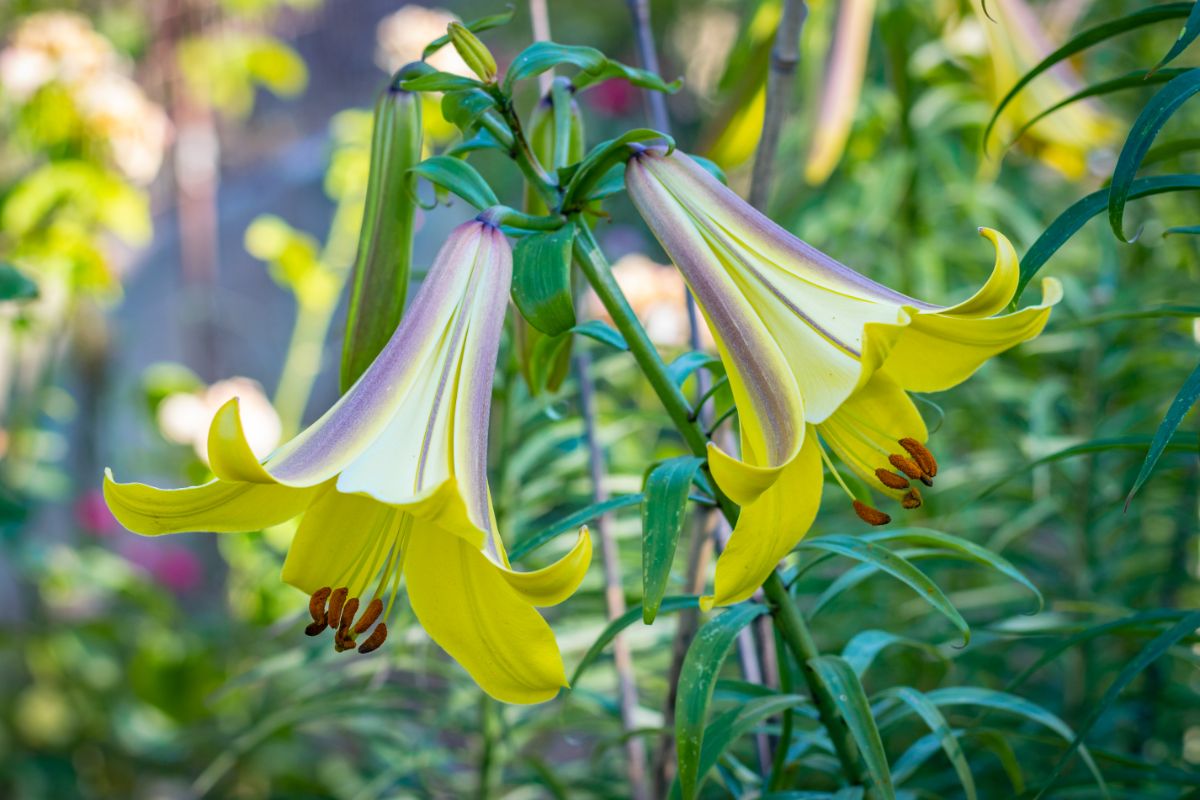
| Plant name: | ‘Golden Splendor’ |
| Lighting requirements: | Full sun |
| Most common bloom color: | Yellow |
| Bloom time: | Summer |
| Growing zone: | Zones 4 to 8 |
Somewhat similar in appearance to ‘African Queen,’ ‘Golden Splendor’ lilies have vivid yellow petals that are complemented by the plant’s purple-toned buds and outer petals. Well-known for their sweet aroma, flowers appear throughout summer and should be deadheaded regularly to maintain the plant’s appearance. Well-adapted for ornamental beds, ‘Golden Splendor’ grows to about 4’ in height.
A very hardy lily variety, ‘Golden Spendor’ can grow in a range of conditions; however, it does require full sun. It can also tolerate cold like a champ and is appropriate for planting in zones 4 through 8.
16. Leopard Lily (Lilium pardilinum)

| Plant name: | Leopard Lily |
| Lighting requirements: | Part shade |
| Most common bloom color: | Orange |
| Bloom time: | Mid-summer |
| Growing zone: | Zones 5 to 9 |
Leopard lilies are the perfect lily to try if you prefer gardens with a more natural appearance. These North American natives have smaller blooms than many other lily species, but flowers are cheerful with bright, golden-orange petals. Petals are spotted with pinkish-red splotches that slightly resemble a leopard’s patterned fur.
Leopard lilies are fine and slender growers, but they can get quite tall (reaching up to 6’). They are also naturally found in wooded areas, which makes them suitable for shadier garden beds. Left on their own, leopard lilies will grow in clumps that look natural in any garden landscape.
17. ‘Forever Susan’ (Lilium ‘Forever Susan’)
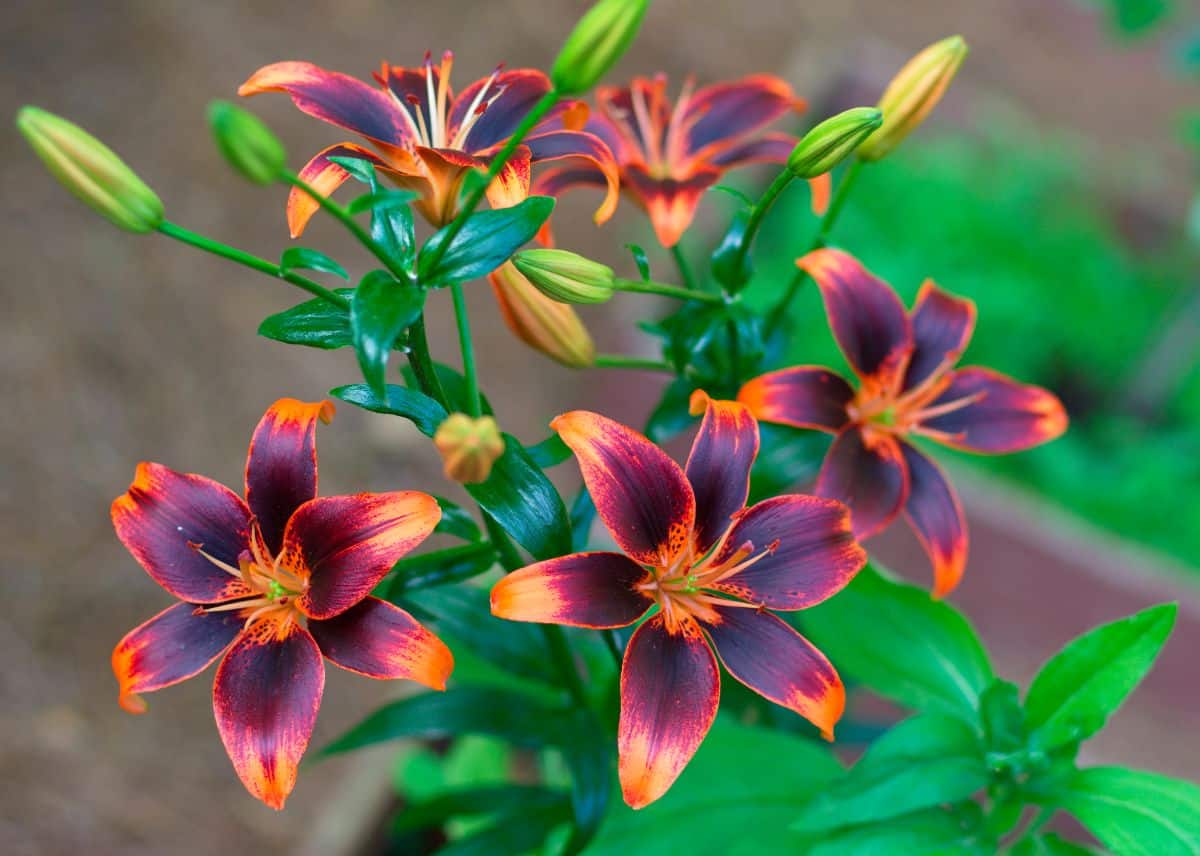
| Plant name: | ‘Forever Susan’ |
| Lighting requirements: | Full sun to part shade |
| Most common bloom color: | Orange and brown |
| Bloom time: | Early to mid-summer |
| Growing zone: | Zones 3 to 9 |
A less commonly grown lily species, ‘Forever Susan’ is named for its resemblance to black-eyed Susans. While the flower shapes are different, this lily’s petals have a similar coloration pattern to the native wildflower: a combination of a rich chocolate brown and a warm golden-orange. That means that these lilies will look exceptionally pretty when planted with black-eyed Susans… or pretty much any other plant!
Hardy to zone 3, ‘Forever Susan’ can adapt to colder locations and perennializes easily. Flowers make their first appearance in early summer, but these plants can continue blooming throughout mid-summer for lots of dramatic garden color. While flowers are very fragrant, they don’t contain pollen, which makes them the perfect plant to try in bouquets.
18. ‘Dizzy’ (Lilium ‘Dizzy’)
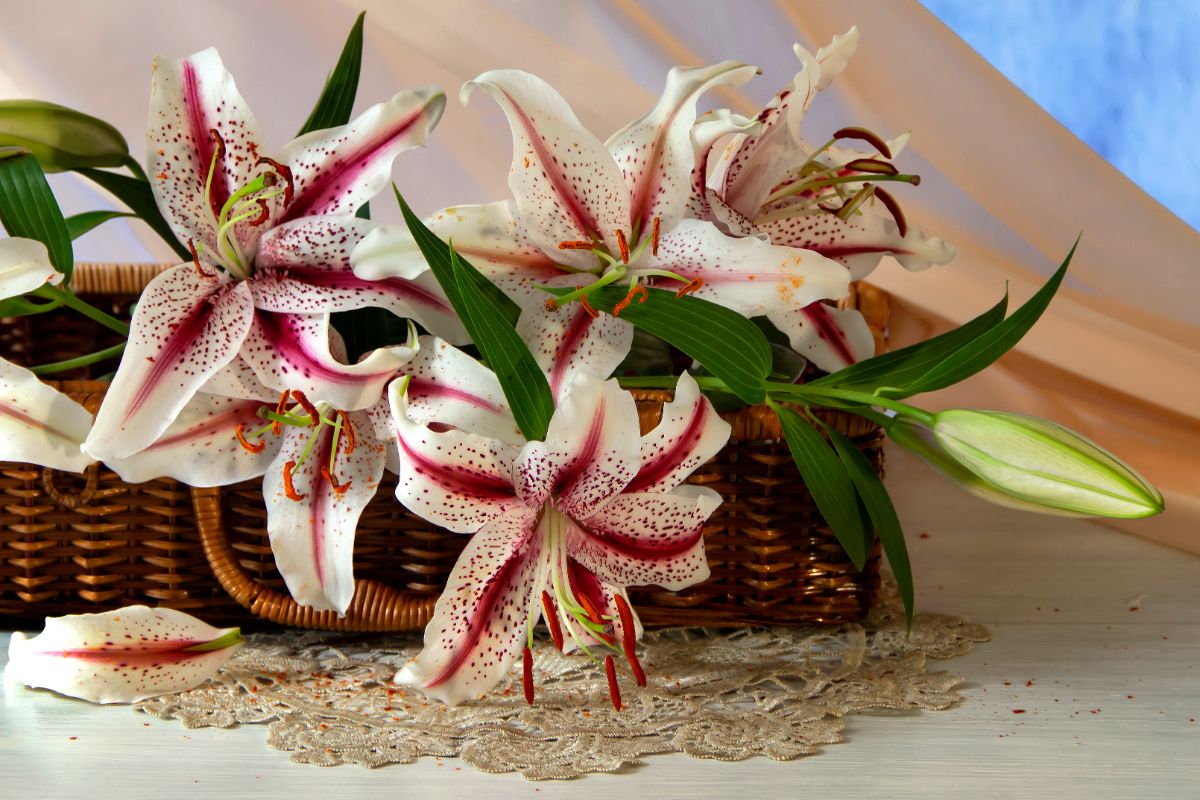
| Plant name: | ‘Dizzy’ |
| Lighting requirements: | Full sun to part shade |
| Most common bloom color: | Pink and white |
| Bloom time: | Mid- to late summer |
| Growing zone: | Zones 5 to 9 |
With a name like ‘Dizzy,’ don’t be surprised if the colorful flowers and heady fragrance of this lily variety make you a bit wild! These vibrant flowers feature bright white blooms with highly contrasting pinkish-red stripes and a profusion of colorful speckles. Petals bend back slightly towards the plant’s stem and have somewhat ruffled margins too.
While these lilies do prefer well-drained soil, they love lots of moisture as well and don’t tolerate dry conditions. Great for inground planting and container gardens alike, try keeping this lily near an open window or your patio. That will ensure you can appreciate its fine fragrance to the fullest!
19. ‘Lollipop’ (Lilium ‘Lollipop’)
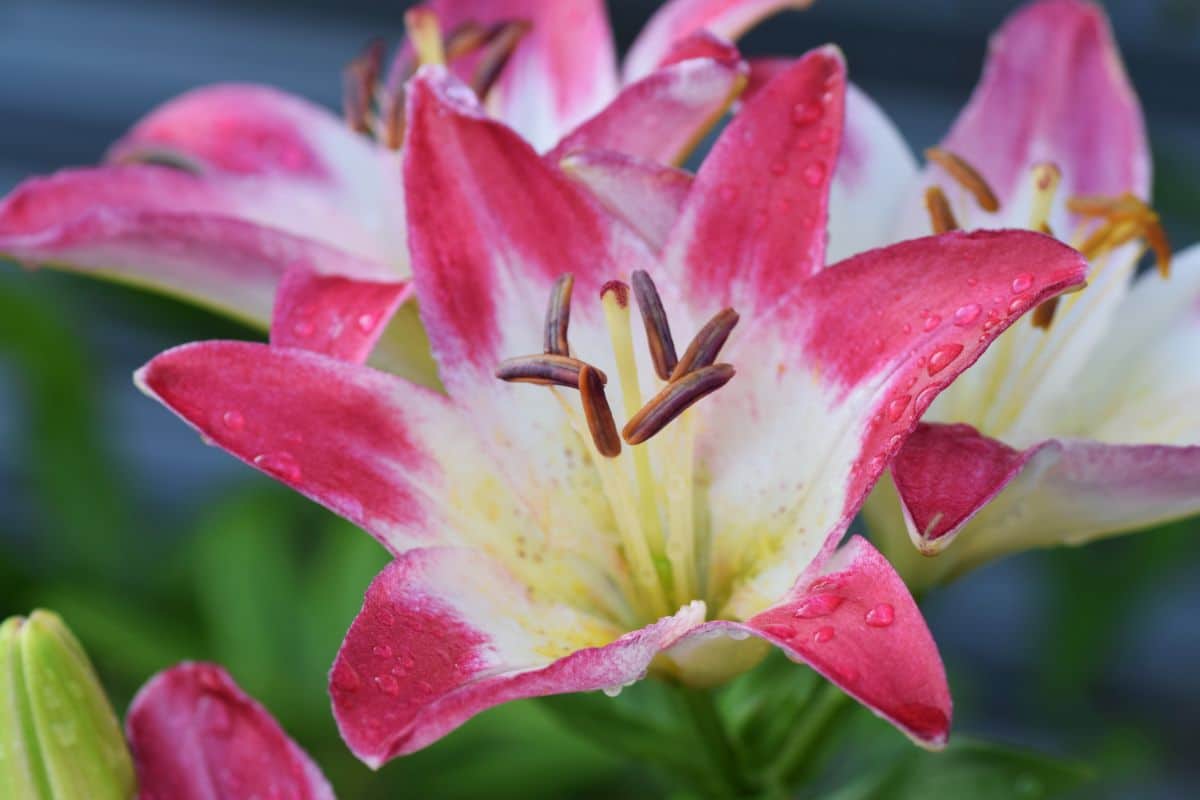
| Plant name: | ‘Lollipop’ |
| Lighting requirements: | Full sun to part shade |
| Most common bloom color: | Pink and white |
| Bloom time: | Mid-summer |
| Growing zone: | Zones 3 to 8 |
‘Lollipop’ lilies have two-toned petals with creamy white centers that fade into pinkish-purple towards the flower’s margins. These upward-facing blooms look best when planted in a grouping, which will both draw the eye and accentuate the flowers’ rich coloration. A dwarf lily variety, ‘Lollipop’, maxes out at about 3’ in height.
Blooms are wider and flatter than many other lily varieties and provide a sweet aroma to garden spaces. Adaptable to both full sun and partially shaded beds, these hardy plants can grow in regions as chilly as zone 3.
20. ‘Turk’s Cap’ (Lilium superbum)
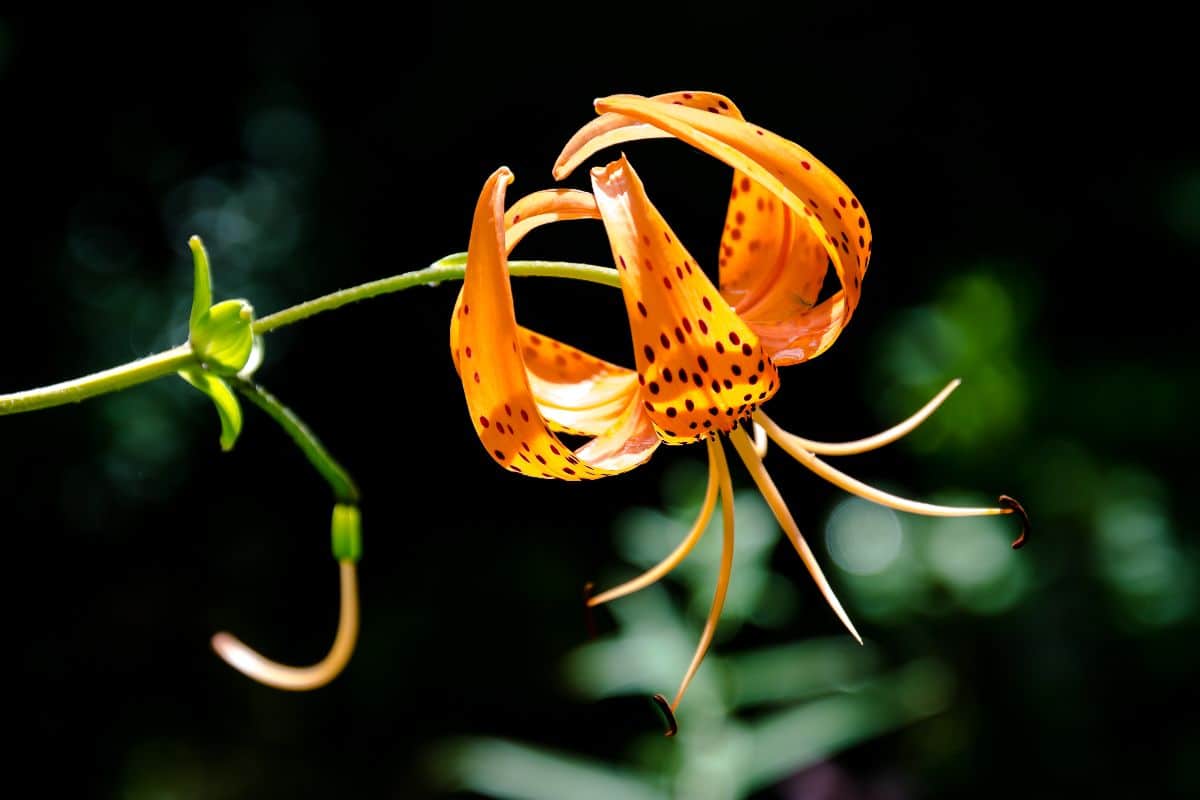
| Plant name: | ‘Turk’s Cap’ |
| Lighting requirements: | Full sun to part shade |
| Most common bloom color: | Orange |
| Bloom time: | Early to mid-summer |
| Growing zone: | Zones 5 to 8 |
Also known as martagon lilies, ‘Turk’s Cap’ are some of the best lilies to try in shadier gardens. A taller variety of lily, these lilies grow between 3 and 6’ high with distinct orange flowers appearing in layers at the top of tall spikes. Flower petals bend back dramatically to create a unique and airy flower shape that has sometimes been described as “pagoda-like.”
While ‘Turk’s Caps’ may look a bit like tiger lilies, they are actually not closely related. In fact, ‘Turk’s Cap’ lilies are native to North America and are one of the largest and most striking native lily types. ‘Turk Cap’ lilies were once commonly found growing along moist streambanks and other wetland locations; however, they are becoming increasingly rare in the wild.
21. ‘Elodie’ (Lilium maculatum ‘Elodie’)
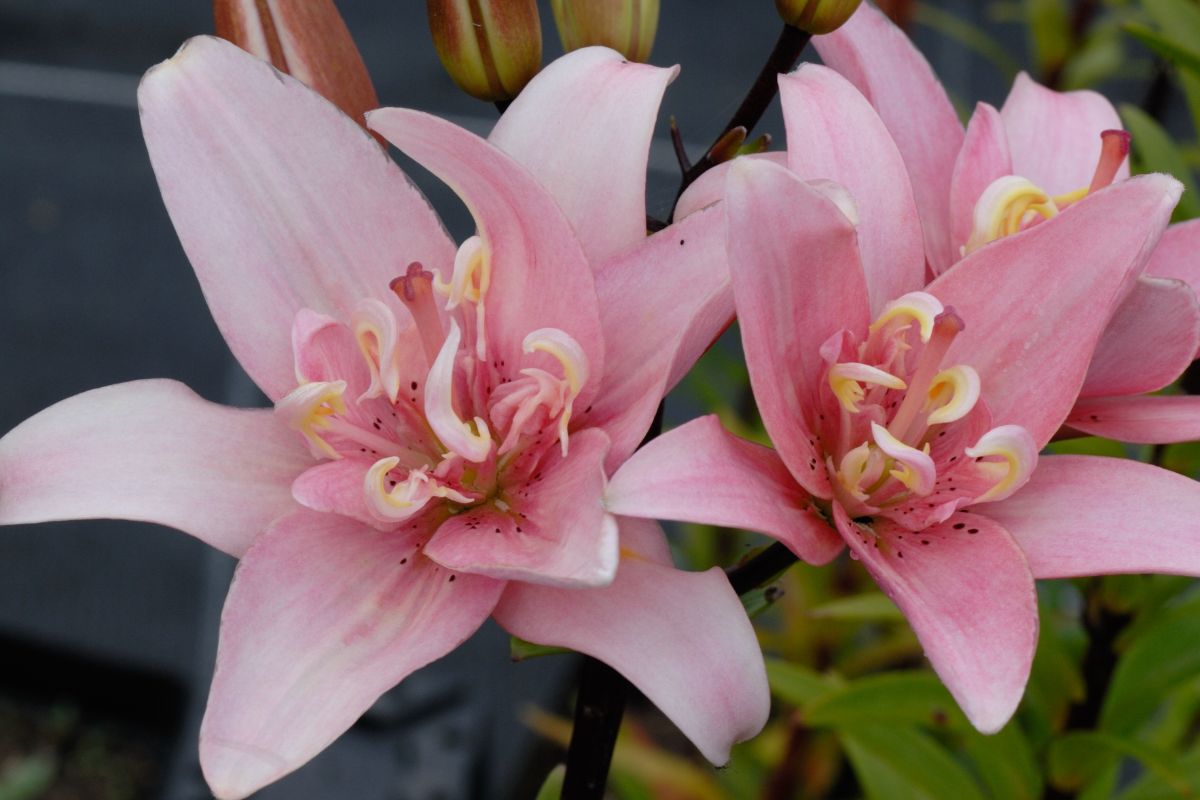
| Plant name: | ‘Elodie’ |
| Lighting requirements: | Full sun to part shade |
| Most common bloom color: | Pink |
| Bloom time: | Early to mid-summer |
| Growing zone: | Zones 4 to 8 |
‘Elodie’ lilies have a very unique look thanks to their semi-double blooms that come in a pale pink hue. These intriguing flowers are pollen-free, making them a good choice for bridal bouquets or cut flower arrangements. What’s more, their pastel coloring can’t help but add a delightful warmth to any garden bed or container garden.
Flowers are ornamented by a fine speckling of raspberry flecks for even more interest. A type of Asiatic lily, ‘Elodie’ grows between 3 and 4’ tall and can adapt to partial shade as well. An early to mid-summer bloomer, ‘Elodie’s’ flowers are quite significant, measuring 5 to 6” in length.
Frequently Asked Questions
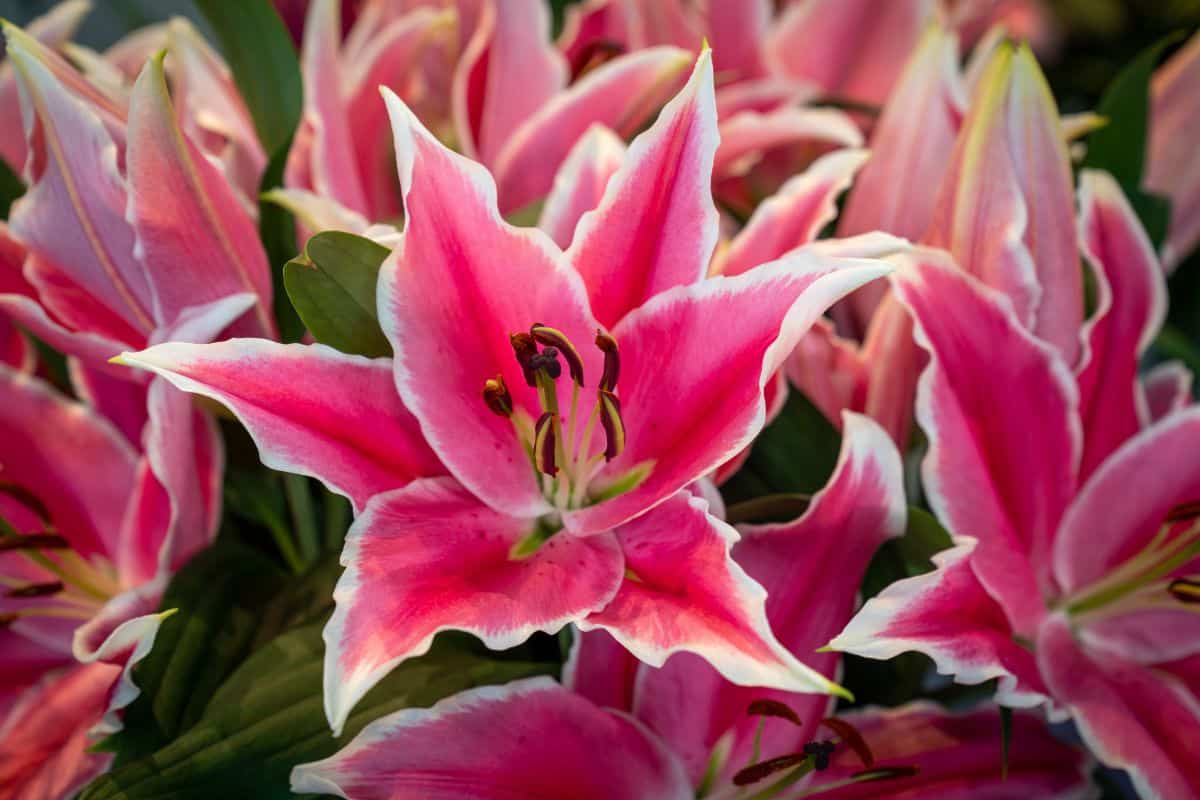
Depending on their size, most lilies can be grown inground or in pots. That said, some lilies don’t tolerate alkaline or clay-heavy soil. In this case, if you can’t amend your soil to suit your plants, container planting is usually recommended.
Generally speaking, lilies are not difficult plants to keep. Just provide them with adequate light (full sun to part shade, depending on the species) and moderate watering, and they should grow quite well. Adding compost or a quality, organic fertilizer that’s rich in potash can also help your plants produce more flowers.
Over time, most lilies will naturally multiply and spread to create an even more impressive garden display. You can encourage this by dividing your lilies every two to three years. For most lily species, early fall is the best time for dividing bulbs.
Deadheading spent flowers after they begin to fade can help keep your lilies looking their best. Removing old flowers will also redirect the plant’s energy back to the plant, which will promote growth and overall health.
Once established, most lily species don’t need a lot of water. However, if your garden is experiencing drought-like conditions, you may want to give your lilies a little extra moisture.
To support their large blooms, lilies will do best with a fertilizer that’s rich in potash. Top-dressing your lily beds with compost, aged manure, or worm castings can also encourage your plants to produce more flowers.
Summary
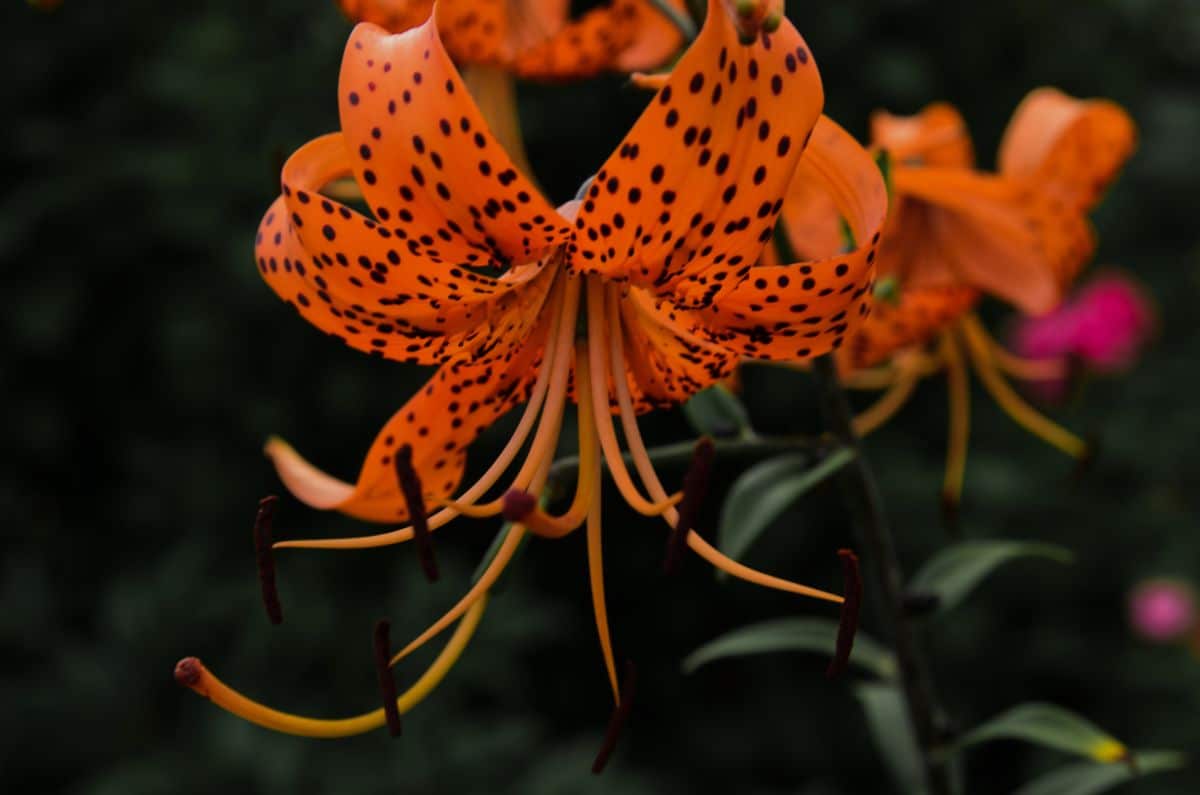
From the natural look of daylilies and leopard lilies to showier ornamentals, like trumpet lilies, there is so much variety in the lily family that you’re sure to find the perfect plant, no matter your aesthetic. Just choose the right lily for your soil type and available light, and you’ll be rewarded with lots of colorful summertime blooms!
We hope you liked this article. But if you’re looking for even more garden inspiration, check out this guide on colorful perennials to try.

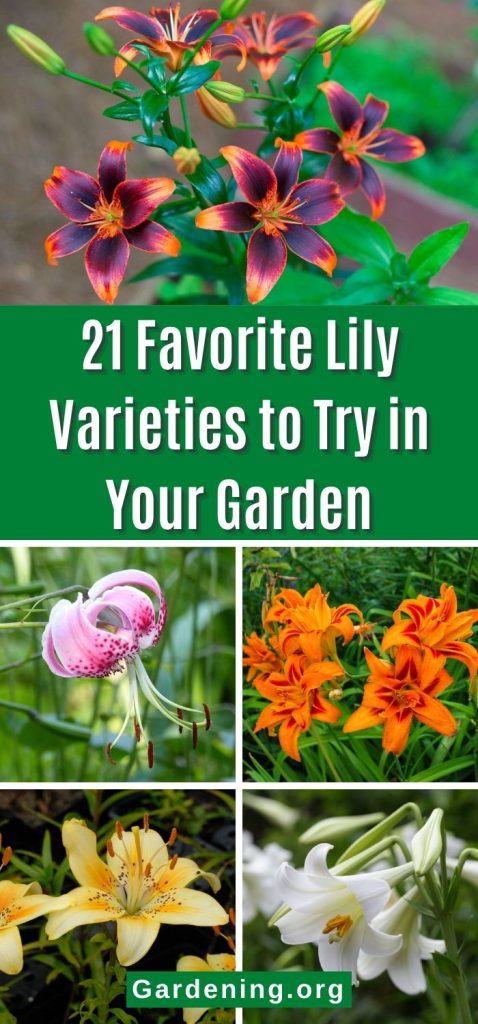
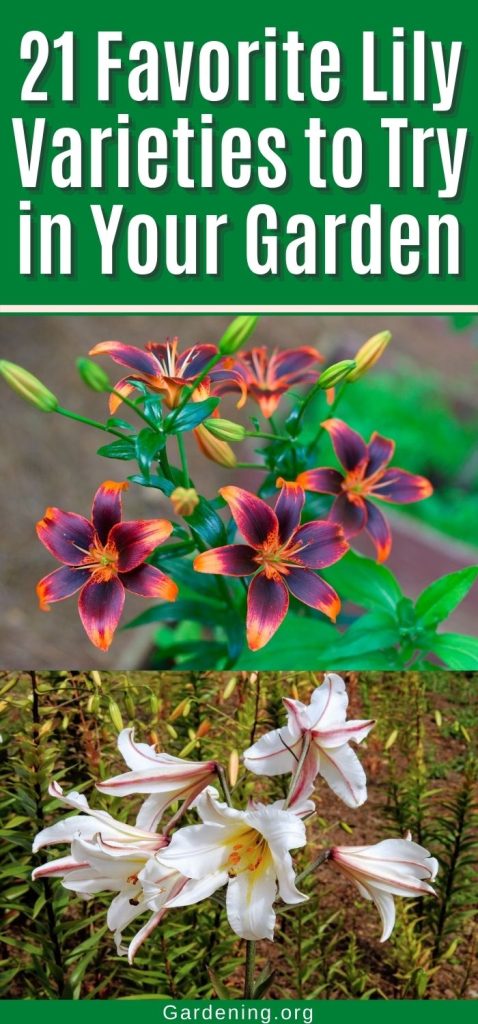
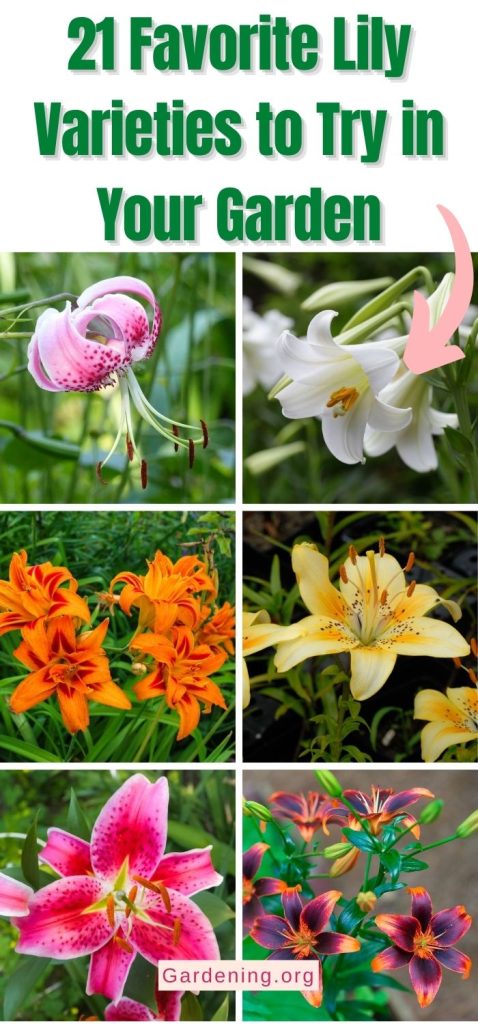
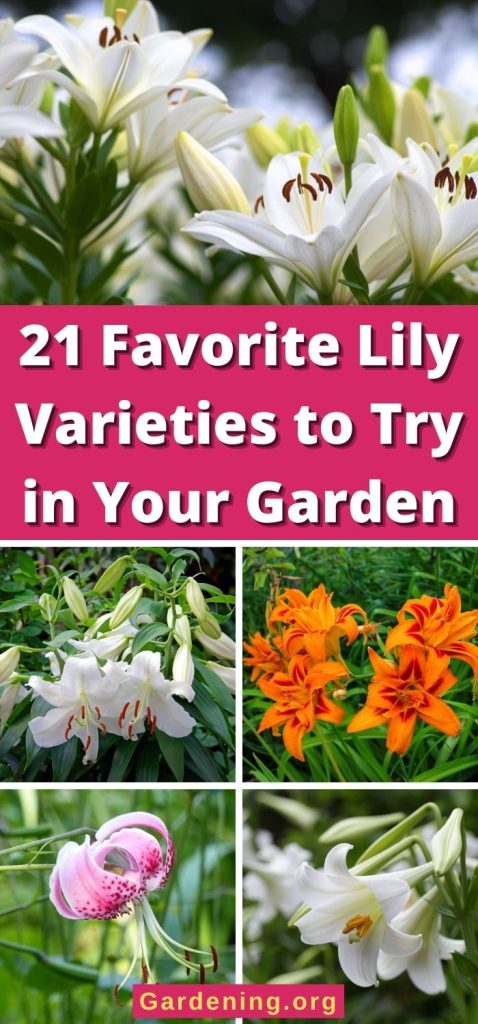

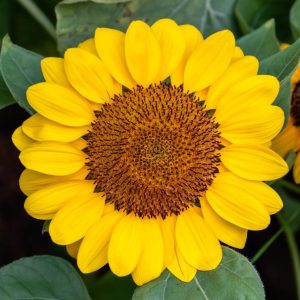

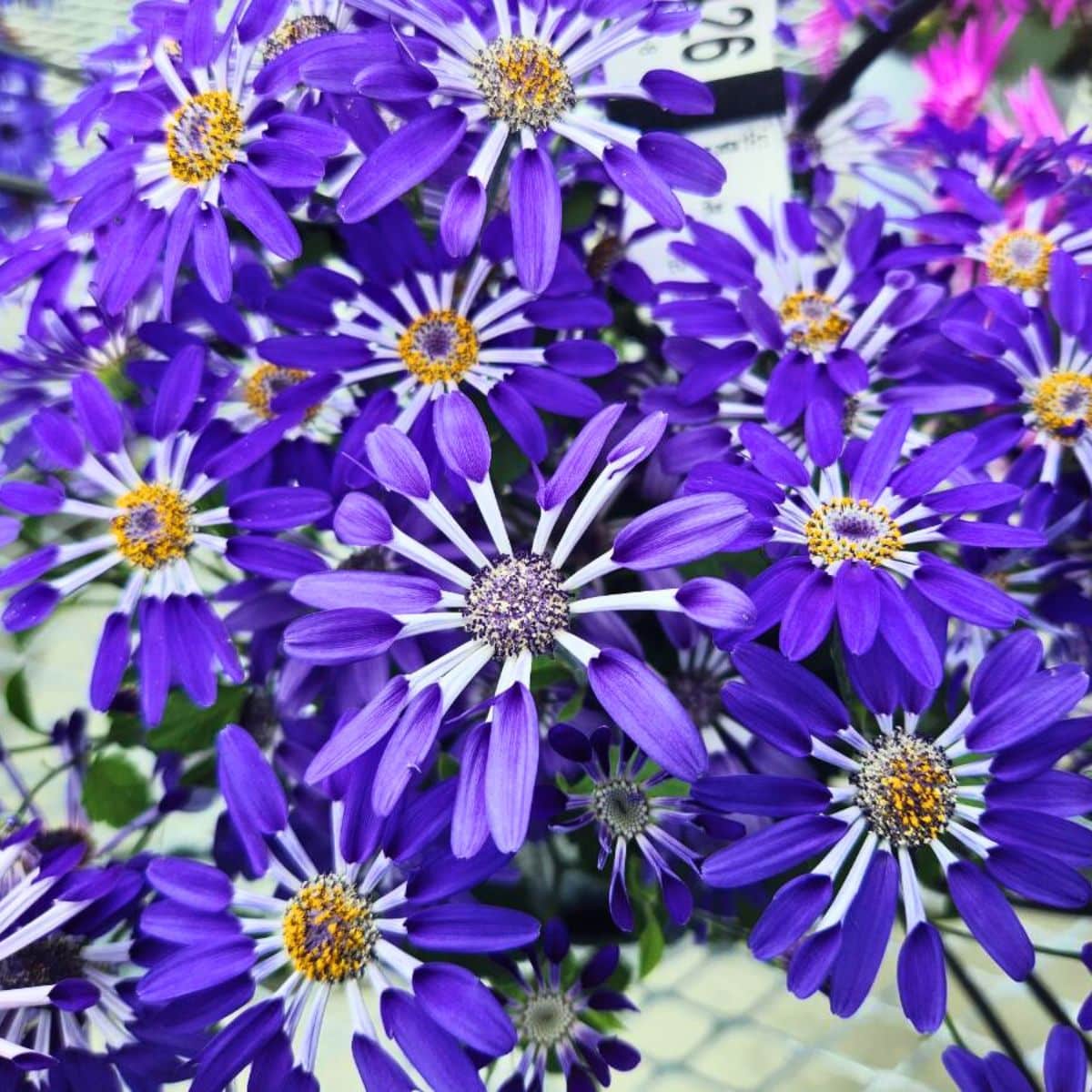
David Zakariya
This is lovely, I like this lilly, how can I get it.
Mary Ward
Try searching and shopping online. You'll find the widest variety online.